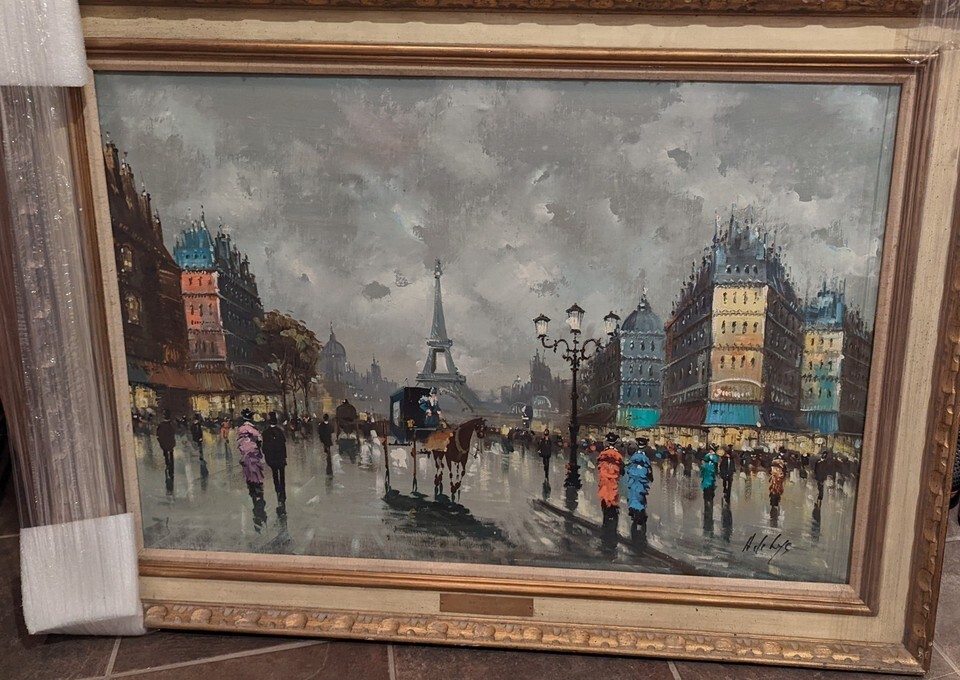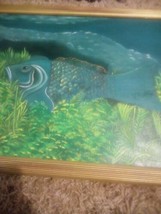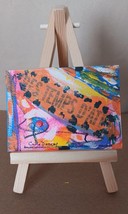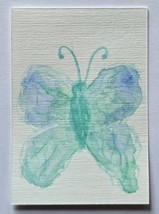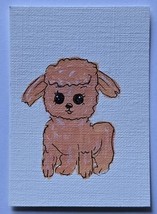Large Original Oil Painting - Devity 1901-93 and 50 similar items
Free Shipping
LARGE ORIGINAL OIL PAINTING - DEVITY 1901-93 - TOUR EIFFEL TOWER - PARIS, FRANCE
$837.50
(It may be possible to pay only $822.50 instead of $837.50 when you
use your bCredits at checkout)
Sign up and get $15.00 bCredits free to use at checkout and another $5.00 bCredits when you make your first purchase. More info
Share & earn! Sign in, share this or any listing, and you’ll get commission when it sells.
Learn more
View full item details »
Shipping options
Estimated to arrive by Fri, Nov 7th.
Details
FREE via Standard shipping (1 to 5 business days) to United States
Offer policy
OBO - Seller accepts offers on this item.
Details
Return policy
None: All purchases final
Details
Purchase protection
Payment options
PayPal accepted
PayPal Credit accepted
Venmo accepted
PayPal, MasterCard, Visa, Discover, and American Express accepted
Maestro accepted
Amazon Pay accepted
Nuvei accepted
View full item details »
Shipping options
Estimated to arrive by Fri, Nov 7th.
Details
FREE via Standard shipping (1 to 5 business days) to United States
Offer policy
OBO - Seller accepts offers on this item.
Details
Return policy
None: All purchases final
Details
Purchase protection
Payment options
PayPal accepted
PayPal Credit accepted
Venmo accepted
PayPal, MasterCard, Visa, Discover, and American Express accepted
Maestro accepted
Amazon Pay accepted
Nuvei accepted
Item traits
| Category: | |
|---|---|
| Quantity Available: |
Only one in stock, order soon |
| Condition: |
Used |
| Medium: |
Oil |
| Style: |
Impressionism |
| Size: |
Large (up to 60in.) |
| Country of Origin: |
France |
| Artist: |
Antonio DeVity |
| Signed: |
Yes |
| Material: |
Canvas |
| Framing: |
Framed |
| Subject: |
Paris |
| Type: |
Painting |
| Original/Licensed Reproduction: |
Original |
| Features: |
One of a Kind (OOAK) |
| Production Technique: |
Oil Painting |
| Handmade: |
Yes |
Listing details
| Seller policies: | |
|---|---|
| Shipping discount: |
Seller pays shipping for this item. |
| Posted for sale: |
October 25 |
| Item number: |
1775375475 |
Item description
This is for a beautiful original oil on canvas by Antonio DeVity depicting downtown Paris with the Eiffel Tower in the distance.
The frame has nicks and bumps here and there but nothing that detracts overall. I can go lower if this ships without the frame. There is also a dedication plaque at the bottom dated 1967 which you can remover/replace. Someone bought their friend this painting. What a nice gift.
This shows a busy Parisian street corner on an overcast day with nicely dressed people, shops, and a horse drawn carriage heading over to pick up two new passengers waiting near a street lamp.
Artist Bio:
Born in Reggio-Calabria in 1901, Italian artist Antonio DeVity was a master of cityscape painting. After moving to Rome during early adulthood he was mentored by the famous painter Giacomo Balla, an artist credited as co-founder of the Futurism movement. The stunning streets of Paris became the focus for Antonio DeVity's impressionism. His work shows historical buildings and places just as they were in the early 1900's because he was actually there.
*For those who are new to fine art note that all of the world famous 'brand name' painters are just that, brand names. They have all been hyped to a great extent. Fine original paintings like this are actually very affordable. This is what fine art actually costs. The majority of vintage original paintings are done by great old masters who were never international household names. Over time it all increases in value so just buy what you like.
Free shipping and insurance in the U.S.
If there's a problem let me know and I'll work with you. My work keeps me away often so to be safe, handling time to get this shipped out is 1 week.
BIDDER SPECIFICS: This has to do with ensuring that new or infrequent buyers have a good experience. If you have less than 20 feedback or had a bad experience in the past 12 months please contact me first. If your feedback is private/hidden please contact me. If you have any questions please just ask.
SHIPPING ADDRESS: I can only send your item to the registered shipping address at time of payment.
WIKI:
The Eiffel Tower (/?a?f?l/ ? EYE-f?l; French: Tour Eiffel [tu? ?f?l] ?) is a wrought-iron lattice tower on the Champ de Mars in Paris, France. It is named after the engineer Gustave Eiffel, whose company designed and built the tower from 1887 to 1889.
Locally nicknamed "La dame de fer" (French for "Iron Lady"), it was constructed as the centrepiece of the 1889 World's Fair, and to crown the centennial anniversary of the French Revolution. Although initially criticised by some of France's leading artists and intellectuals for its design, it has since become a global cultural icon of France and one of the most recognisable structures in the world.[5] The tower received 5,889,000 visitors in 2022.[6] The Eiffel Tower is the most visited monument with an entrance fee in the world:[7] 6.91 million people ascended it in 2015. It was designated a monument historique in 1964, and was named part of a UNESCO World Heritage Site ("Paris, Banks of the Seine") in 1991.[8]
The tower is 330 metres (1,083 ft) tall,[9] about the same height as an 81-storey building, and the tallest structure in Paris. Its base is square, measuring 125 metres (410 ft) on each side. During its construction, the Eiffel Tower surpassed the Washington Monument to become by far the tallest human-made structure in the world, a title it held for 41 years until the Chrysler Building in New York City was finished in 1930. It was the first structure in the world to surpass both the 200 meters and 300 meters mark in height. Due to the addition of a broadcasting aerial at the top of the tower in 1957, it is now taller than the Chrysler Building by 5.2 metres (17 ft). Excluding transmitters, the Eiffel Tower is the second tallest free-standing structure in France after the Millau Viaduct.
The tower has three levels for visitors, with restaurants on the first and second levels. The top level's upper platform is 276 m (906 ft) above the ground?the highest public observation deck in the European Union. Tickets can be purchased to ascend by stairs or lift to the first and second levels. The climb from ground level to the first level is over 300 steps, as is the climb from the first level to the second, making the entire ascent a 600-step climb. Although there is a staircase to the top level, it is usually accessible only by lift. On this top, third level, is a private apartment built for Gustave Eiffel, who decorated it with furniture made by Jean Lachaise and invited friends such as Thomas Edison.
Origin
The design of the Eiffel Tower is attributed to Maurice Koechlin and Emile Nouguier, two senior engineers working for the Compagnie des Etablissements Eiffel. It was envisaged after discussion about a suitable centrepiece for the proposed 1889 Exposition Universelle, a world's fair to celebrate the centennial of the French Revolution. In May 1884, working at home, Koechlin made a sketch of their idea, described by him as "a great pylon, consisting of four lattice girders standing apart at the base and coming together at the top, joined together by metal trusses at regular intervals".[10] Eiffel initially showed little enthusiasm, but he did approve further study, and the two engineers then asked Stephen Sauvestre, the head of the company's architectural department, to contribute to the design. Sauvestre added decorative arches to the base of the tower, a glass pavilion to the first level, and other embellishments.[citation needed]
First drawing of the Eiffel Tower by Maurice Koechlin including size comparison with other Parisian landmarks such as Notre Dame de Paris, the Statue of Liberty, and the Vendome Column
The new version gained Eiffel's support: he bought the rights to the patent on the design which Koechlin, Nouguier, and Sauvestre had taken out, and the design was put on display at the Exhibition of Decorative Arts in the autumn of 1884 under the company name. On 30 March 1885, Eiffel presented his plans to the Societe des Ingenieurs Civils; after discussing the technical problems and emphasising the practical uses of the tower, he finished his talk by saying the tower would symbolise
[n]ot only the art of the modern engineer, but also the century of Industry and Science in which we are living, and for which the way was prepared by the great scientific movement of the eighteenth century and by the Revolution of 1789, to which this monument will be built as an expression of France's gratitude.[11]
Little progress was made until 1886, when Jules Grevy was re-elected as president of France and Edouard Lockroy was appointed as minister for trade. A budget for the exposition was passed and, on 1 May, Lockroy announced an alteration to the terms of the open competition being held for a centrepiece to the exposition, which effectively made the selection of Eiffel's design a foregone conclusion, as entries had to include a study for a 300 m (980 ft) four-sided metal tower on the Champ de Mars.[11] (A 300-metre tower was then considered a herculean engineering effort.) On 12 May, a commission was set up to examine Eiffel's scheme and its rivals, which, a month later, decided that all the proposals except Eiffel's were either impractical or lacking in details.[citation needed]
After some debate about the exact location of the tower, a contract was signed on 8 January 1887. Eiffel signed it acting in his own capacity rather than as the representative of his company, the contract granting him 1.5 million francs toward the construction costs: less than a quarter of the estimated 6.5 million francs. Eiffel was to receive all income from the commercial exploitation of the tower during the exhibition and for the next 20 years. He later established a separate company to manage the tower, putting up half the necessary capital himself.[12]
A French bank, the Credit Industriel et Commercial (CIC), helped finance the construction of the Eiffel Tower. During the period of the tower's construction, the CIC was acquiring funds from predatory loans to the National Bank of Haiti, some of which went towards the financing of the tower. These loans were connected to an indemnity controversy that saw France force Haiti's government to financially compensate French slaveowners for lost income as a result of the Haitian Revolution, and required Haiti to pay the CIC and its partner nearly half of all taxes collected on exports, "effectively choking off the nation's primary source of income". According to The New York Times, "[at] a time when the [CIC] was helping finance one of the world's best-known landmarks, the Eiffel Tower, as a monument to French liberty, it was choking Haiti's economy, taking much of the young nation's income back to Paris and impairing its ability to start schools, hospitals and the other building blocks of an independent country."[13]
Artists' protest
Caricature of Gustave Eiffel comparing the Eiffel tower to the Pyramids, published in Le Temps, 14 February 1887
The proposed tower had been a subject of controversy, drawing criticism from those who did not believe it was feasible and those who objected on artistic grounds. Prior to the Eiffel Tower's construction, no structure had ever been constructed to a height of 300 m, or even 200 m for that matter,[14] and many people believed it was impossible. These objections were an expression of a long-standing debate in France about the relationship between architecture and engineering. It came to a head as work began at the Champ de Mars: a "Committee of Three Hundred" (one member for each metre of the tower's height) was formed, led by the prominent architect Charles Garnier and including some of the most important figures of the arts, such as William-Adolphe Bouguereau, Guy de Maupassant, Charles Gounod and Jules Massenet. A petition called "Artists against the Eiffel Tower" was sent to the Minister of Works and Commissioner for the Exposition, Adolphe Alphand, and it was published by Le Temps on 14 February 1887:
We, writers, painters, sculptors, architects and passionate devotees of the hitherto untouched beauty of Paris, protest with all our strength, with all our indignation in the name of slighted French taste, against the erection ... of this useless and monstrous Eiffel Tower ... To bring our arguments home, imagine for a moment a giddy, ridiculous tower dominating Paris like a gigantic black smokestack, crushing under its barbaric bulk Notre Dame, the Tour Saint-Jacques, the Louvre, the Dome of les Invalides, the Arc de Triomphe, all of our humiliated monuments will disappear in this ghastly dream. And for twenty years ... we shall see stretching like a blot of ink the hateful shadow of the hateful column of bolted sheet metal.[15][16]
A 1918 calligram by Guillaume Apollinaire: Salut monde dont je suis la langue eloquente que sa bouche O Paris tire et tirera toujours aux allemands ("Hello world, of which I am the eloquent tongue which your mouth, O Paris, will forever stick out at the Germans").
Gustave Eiffel responded to these criticisms by comparing his tower to the Egyptian pyramids: "My tower will be the tallest edifice ever erected by man. Will it not also be grandiose in its way? And why would something admirable in Egypt become hideous and ridiculous in Paris?"[17] These criticisms were also dealt with by Edouard Lockroy in a letter of support written to Alphand, sardonically saying,[18] "Judging by the stately swell of the rhythms, the beauty of the metaphors, the elegance of its delicate and precise style, one can tell this protest is the result of collaboration of the most famous writers and poets of our time", and he explained that the protest was irrelevant since the project had been decided upon months before, and construction on the tower was already under way.
Garnier was a member of the Tower Commission that had examined the various proposals, and had raised no objection. Eiffel pointed out to a journalist that it was premature to judge the effect of the tower solely on the basis of the drawings, that the Champ de Mars was distant enough from the monuments mentioned in the protest for there to be little risk of the tower overwhelming them, and putting the aesthetic argument for the tower: "Do not the laws of natural forces always conform to the secret laws of harmony?"[19]
Some of the protesters changed their minds when the tower was built; others remained unconvinced.[20] Guy de Maupassant supposedly ate lunch in the tower's restaurant every day because it was the one place in Paris where the tower was not visible.[21]
By 1918, it had become a symbol of Paris and of France after Guillaume Apollinaire wrote a nationalist poem in the shape of the tower (a calligram) to express his feelings about the war against Germany.[22] Today, it is widely considered to be a remarkable piece of structural art, and is often featured in films and literature.
Construction
Foundations of the Eiffel Tower, photographed in 1887
Work on the foundations started on 28 January 1887.[23] Those for the east and south legs were straightforward, with each leg resting on four 2 m (6.6 ft) concrete slabs, one for each of the principal girders of each leg. The west and north legs, being closer to the river Seine, were more complicated: each slab needed two
(description exceeds maximum possible length)
|
Why are we showing these items?
Search Results
Painting, paintings"painting" Category "Paintings"
|

-
Refine your browsing experience
We can show you more items that are exactly like the original item, or we can show you items that are similar in spirit. By default we show you a mix.
This item has been added to your cart
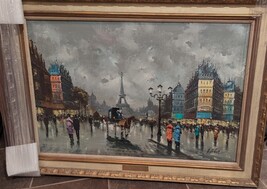 LARGE ORIGINAL OIL PAINTING - DEVITY 1901-93 - TOUR EIFFEL TOWER - PARIS, FRANCE added to cart.
Only one available in stock
LARGE ORIGINAL OIL PAINTING - DEVITY 1901-93 - TOUR EIFFEL TOWER - PARIS, FRANCE added to cart.
Only one available in stock
View Cart or continue shopping.
 Please wait while we finish adding this item to your cart.
Please wait while we finish adding this item to your cart.
Get an item reminder
We'll email you a link to your item now and follow up with a single reminder (if you'd like one). That's it! No spam, no hassle.
Already have an account?
Log in and add this item to your wish list.



